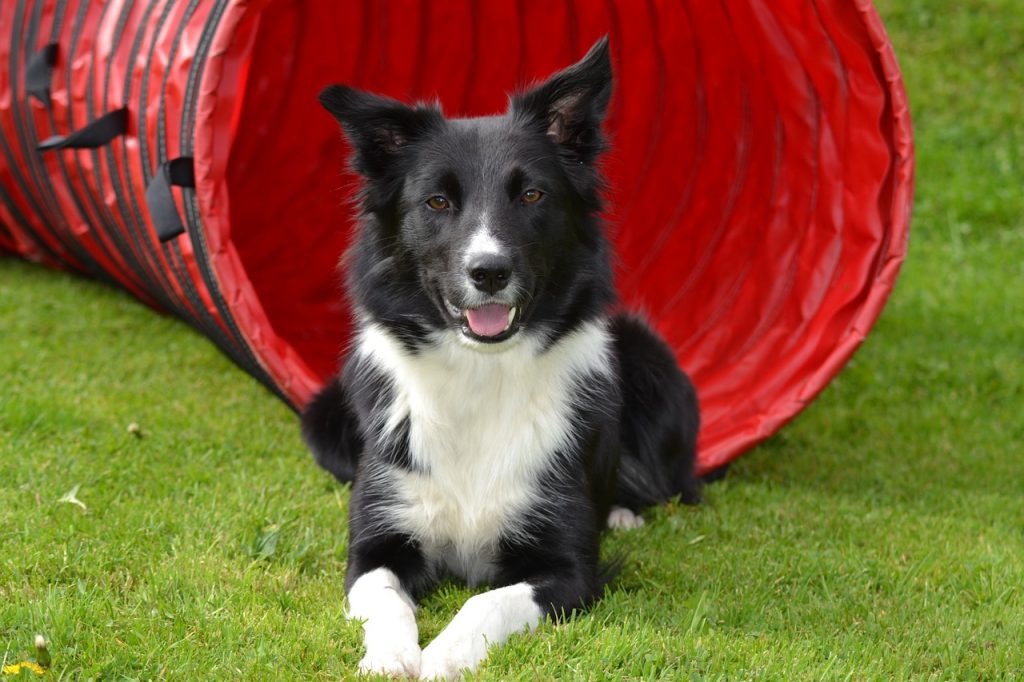Low back injuries in agility dogs can range from simple mechanical low back pain, to more serious acute disc injury and nerve compression. Without significant trauma, these injuries often present with subtle changes in performance. If ignored, these injuries may become more pronounced over time.
*The information in this article is also applicable to performance dogs competing in other sports.
Diagnosis of Low Back Injuries in Agility Dogs
As an agility dog owner it’s important that you don’t brush small performance or behavioral changes off. Have a professional (ideally one who specializes in the assessment of performance dogs) do a thorough physical assessment. These professionals include:
- Veterinarians specializing in Rehabilitation, Sports, or Orthopedic
- Canine Physiotherapist or Physical Therapist
- Canine Chiropractor
- Canine Osteopath
Your dogs entire musculoskeletal system needs to be checked. If nothing obvious is found on physical examination, or if something is found that warrants further investigation, scans may be required. In the case of the low back, an MRI is the gold standard for diagnosing disc changes and nerve compression.
If an MRI demonstrates a disc injury, a Veterinary specialist will be able to determine the optimal treatment plan. If conservative treatment is considered appropriate for your dogs case, the treatment should continue under the supervision of your specialist.
If you would like more information on the diagnosis of low back injuries in agility dogs please click here.
Surgery for Low Back Injuries
Surgery may be indicated if your dog has:
- Signs of nerve compression or instability with scans supporting a surgical approach
- Failure to achieve a complete resolution with conservative treatment
There are a number of surgeries for low back injuries. The most common surgery for disc injury with nerve compression is called a laminectomy.
In a laminectomy the spine is approached through an incision in the back. Using a special drill, a window is made in the vertebra above the disc. The disc material is then removed to decompress the spinal cord and /or nerves.
If there is instability, a spinal fusion may also be performed. A fusion eliminates movement at the spinal level.
Surgical procedures for disc injuries and instability (without bladder / bowel incontinence) have a reported success rate of 75-90% (source). Rehabilitation may take weeks to months with some dogs able to return to pre-injury activities.
Conservative Treatment of Low Back Injuries in Agility Dogs
Given the sometimes subtle signs and the cost of an MRI, you may decide to start conservative treatment for low back injuries prior to obtaining an MRI. The treatment plan needs to include expectations and time frames.
- How long are you going to pursue conservative treatment before further scans or treatment (e.g. surgery) are required?
- What if your dogs symptoms become worse (e.g. nerve function deteriorates)?
- What is required of you, the dogs owner, during this time (rest, play, exercises etc)?
- What if the performance issue returns after resolution?
It is of upmost importance that you fully understand whether your dog should be training and / or competing in agility during this time. While it may be hard to hear because your dog ‘loves’ agility and doesn’t look in pain, you need to understand the risks of continuing to train and compete.
Agility dogs are often high drive dogs and will continue to work despite an injury.
Conservative treatment may include a mix of traditional Veterinary treatment, as well as the inclusion of complementary therapies.
Veterinary Treatment for Low Back Injuries in Agility Dogs
Nonsteroidal anti-inflammatory drugs (NSAID’s):
NSAIDs help reduce swelling, stiffness, and joint pain. They can provide excellent relief for a dog with a low back injury. NSAID’s are however known for causing side effects, so it’s important that you discuss these with your Vet.
Examples of some of the available NSAIDs just for dogs include:
- carprofen (Novox or Rimadyl)
- meloxicam (Metacam)
- deracoxib (Deramaxx)
- firocoxib (Previcox)
Never give your dog a human NSAID (e.g. nurofen, motrin, voltaren) without the express permission of your treating Vet.
While your dogs performance may improve while on medication, it’s important that you don’t continue to compete with the medications masking the symptoms. The cause of the problem needs to be addressed and treated accordingly.
Other Medications:
Because NSAIDs are usually good at relieving pain, Vets don’t often need to prescribe other kinds of painkillers. Sometimes however, your dog may need more options. Your Vet may talk to you about drugs like gabapentin or tramadol.
Complementary Therapies for Low Back Injuries in Agility Dogs
Complementary therapies may be used as part of your dog’s treatment, or as part of a comprehensive maintenance / prevention program.
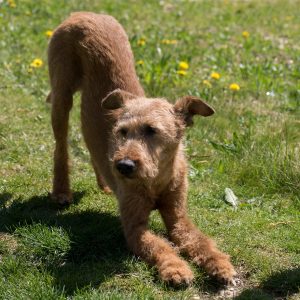
Manual Therapy:
The goal of manual therapy is to balance the musculoskeletal system and restore homeostasis through a “hands on” approach. If joints are struggling it may be because the muscles are tight, putting more strain through the area. Or it may be because adjacent joints aren’t working optimally.
Manual therapists can’t fix pathological changes to tissues (e.g. disc injuries) but they can use techniques to minimize any extra strain going through the area.
Take for example a discogenic low back pain (LBP) at the lumboscaral junction (L7/S1). If the thoracic spine and hips aren’t functioning optimally, or the muscles in the area are tight, it may lead to more strain going through the lumbosacral area. Remove the tightness in the thoracic spine, hip flexors (iliopsoas), and hips, and it may ease the excess strain, and therefore the pain. It doesn’t get rid of the problem, but it allows the body the best chance of healing.
Manual therapists include Physiotherapists / Physical Therapists, Osteopaths, and Chiropractors with post graduate training in the treatment of animals. They are registered health professionals. The philosophies differ slightly but they’re all essentially trying to achieve the same result – improve function and decrease pain.
There are also some massage therapists with further training in massage for dogs. Massage therapists can improve muscle health but they don’t have the assessment and diagnostic skills that the manual therapists above have. Some are however very skilled in a newly developing field.
Exercise Rehabilitation:
Exercise rehabilitation is an important component of your dogs rehabilitation and ongoing management. It will ensure any strength or range of motion deficits will be addressed and corrected.
Exercise rehabilitation programs can be provided by professionals that have completed the CCRP or CCRT course in the USA (look for these letters in their qualification). Alternatively, a Physiotherapist / Physical Therapist with post graduate training in canine rehabilitation would also be an excellent source of advice.
Exercise rehabilitation programs may include treatment delivered by the practitioner, as well as home exercises. These exercises may include:
- Core strengthening (more details below)
- Back leg strengthening (especially if one of the legs has been affected by sciatica)
- Balance / stability and proprioception
- Flexibility / stretching
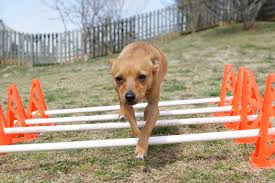
Core Strengthening:
In the case of low back injuries in dogs, a strong core is of upmost importance. Core strengthening may form part of a rehabilitation or prevention program.
Dave Munnings of Q-Me Agility in the UK has put together an excellent two-part video on core strengthening*.
*If your dog is currently rehabilitating a low back injury core exercises should only be completed under the guidance of your rehabilitation professional.
Hydrotherapy:
Hydrotherapy is a form of exercise rehabilitation and may occur on an underwater treadmill, or in a pool supervised by a rehab professional.
Underwater treadmills are excellent for dogs struggling to walk normally after a low back injury. The buoyancy of the water offloads some of their weight allowing them to move more normally. Over time the controlled exercise strengthens their muscles and may allow them to return to pain free walking.
Swimming vs Hydrotherapy:
Swimming usually occurs in a less controlled environment. It can be beneficial for mild or moderate cases of low back pain where your dog is still relatively healthy and normal in its gait.
In more severe cases, or acute flares, swimming may however be counterproductive. It is harder to control speed, intensity, or proper limb use. If they do use all four limbs while swimming, they also use a different pattern than a walking gait. This is important for dogs that are learning how to walk again.

Acupuncture:
Acupuncture is an ancient branch of Traditional Chinese Medicine (TCM). It’s been used in both people and animals for thousands of years. Acupuncture utilizes the body’s own ability to heal itself. Through this, it establishes health and balance in the patient.
Acupuncture can be delivered by TCM practitioners or by registered health professionals and Vets who have completed a Veterinary Acupuncture course. It is often a stand alone treatment.
Dry needling differs in its philosophy and the training required. Dry needling is a short course for registered health professionals and massage therapists. It focuses on the use of needles to target tight muscles or “trigger points”. Dry needling can be an effective conservative treatment option in low back injuries, and is often combined with manual therapy. In Australia there are limited courses in the use of Dry Needling in Dogs.
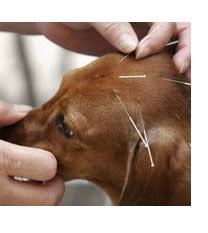
Laser Therapy:
Laser therapy is still a relatively new concept that is being used more recently to treat dogs with arthritis, tendon or soft tissue injuries, and to promote wound healing.
Laser therapy uses deep-penetrating light to promote a chain of chemical reactions known as photobiostimulation. This process helps relieve pain through the release of endorphins, as well as stimulating injured cells to heal at an accelerated pace.
Treatment usually involves 2-8 visits that take approximately 3-8 minutes. It may be used as a stand-alone treatment, or in conjunction with manual therapy and/or exercise rehabilitation.
Training in Laser therapy usually involves a short course with the company the laser unit is purchased from. There are comprehensive treatment protocols that are applied to certain presenting complaints. The delivery of laser therapy to dogs does not seem to be regulated.
Who is Delivering your Dog’s Complementary Therapy?
In the UK and certain US states, the treatment of dogs must be under the supervision of a Vet. This means you need to have a Veterinary referral before complementary practitioners can treat your dog.
In a lot of countries, Australia included (and some US states), the treatment of dogs is not regulated. This can lead to people with weekend courses saying they treat dogs using all sorts of unregulated treatment techniques.
Check your practitioners qualifications. Physiotherapy, Physical Therapy, Osteopathy, and Chiropractor are all protected terms in Australia and most Western countries, so anyone calling themselves that MUST be registered with their government body.
This however does not automatically qualify any of these registered health professionals to treat animals. Further training is required. Some of the post graduate courses include:
- American Veterinary Chiropractic Association (AVCA): The primary national credential for Veterinary Chiropractic in North America. Certification is available to Vets and Chiropractors on completion of one of several courses, and completion of the AVCA Animal Chiropractic Certification Commission (ACCC) examinations.
- Master of Physiotherapy: Some countries also have a protected title called Animal Physiotherapist which is restricted with in their profession.
- Graduate Diploma in Animal Biomechanics: Available to Vets, Osteopaths and Chiropractors in Australia.
- Diploma in Animal Osteopathy: Available to Osteopaths in the UK (also available from time to time in Australia and New Zealand).
- Master of Science – Animal Manipulation: Available in the UK for Chiropractors and Osteopaths.
- CCRT – Certified Canine Rehabilitation Therapist: Delivered by the Canine Rehabilitation Institute in conjunction with Colorado State University. Available to Vets and Physical Therapists.
- CCRP – Certified Canine Rehabilitation Practitioner: Delivered by the University of Tennessee. Available to Vets, Physical Therapists, and approved health professionals (by application only).
- Veterinary Acupuncture: Acupuncture training for Vets and approved health professionals (by application).
Massage therapy is not as well regulated as the registered health professions so my only advice is to check their qualifications and registration against your countries / states requirements. Also check the level of training they’ve completed in the treatment of dogs. Referrals from agility dog clubs, and other agility dog owners, are also helpful in this situation.
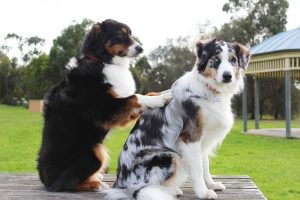
Return to Dog Agility after a Low Back Injury
Low back injuries in agility dogs can take months to resolve. Most treatment programs include periods of rest, followed by a progressive rehabilitation program that is considered successful when your dog can return to everyday activities (e.g. walking, running, playing).
If you’re lucky and you have access to a rehabilitation professional that works with agility dogs, your rehab program will also include a return to sport section. In this case, what I say below will likely be included in your program.
After an injury it’s important that you consider your dogs return to sport. There needs to be a progressive reintroduction of each of the individual aspects of agility. Factors that will influence the length of this process include:
- The severity of the dogs low back injury
- Whether surgery was required and if so, what surgical procedure was performed
- The age and conditioning of your dog prior to the injury
- The length of time your dog has been rested from training and competition
- Any technical correction that is required
This process is no different to you returning to a sport after an injury. Say you tore your calf and want to return to soccer. Your rehab program will probably include progressive assisted eccentric only calf raises. Slowly you’ll be able to add double leg calf raises and then single leg calf raises. Once you’re able to complete 3 sets of 15 repetitions of single leg calf raises you can then consider reintroducing running. This can take anywhere from a couple of weeks (grade 1 – fibres stretched) to six months (grade 3 – full tear).
You could think at this stage, since you’ve been cleared for running, you’re good for soccer too? Well, you could try playing and if you’re lucky you’ll finish the game without re-injuring yourself. Chances are though, you’ll re-injure your calf and end up back at square one. Sadly I hear this all too often.
I’ve chosen a calf injury to explain my point as it seems like a relatively benign, simple injury. It’s probably more straight forward to rehabilitate than a low back injury, but grade 3 calf injuries can take 9-12 months to return to sport.
So lets get back to your calf injury…
You’ve been cleared for running. Running however, is not the only skill in soccer. You’ve got to be able to stop and start quickly, change direction, kick a ball, and tackle. And you’ve got to be able to do this for up to 90 minutes.
Your return to sport program needs to include each of these individual skills, building intensity and endurance. Once you’ve progressively reintroduced each of these skills with good technique, and without any stiffness or pain, you’re ready to introduce some game time.
The next game rolls up and you play as a substitute in the last quarter. If you pull up well, game time can be increased until you’re able to play a full game without issue. Congratulations, your injury is now fully rehabilitated!
Agility is no different. Your dog can’t go from being able to go for a run and play with his mates, to an agility competition, or full training for that matter. You need to progressively reintroduce each of the skills.
This may mean that you start with a low jump in a straight line. During your first session you may only repeat this 3-5 times and see how your dog responds over the next 24 hours. Are your dogs behaviors and movements normal, or are they showing signs of pain or stiffness? If they pull up well you can either progress this exercise (more repetitions OR higher jump, not both), or add an additional exercise.
This process continues until your dog is able to complete each of the skills individually without issue. The skills can then be progressively chained together. Only then should you consider returning your dog to agility competition.
While this may seem exhaustive, it gives your dog the best chance of a safe return to sport and complete resolution of the injury. This process may take a few weeks or several months in more serious injuries. In some cases your dog may not be able to return to agility.
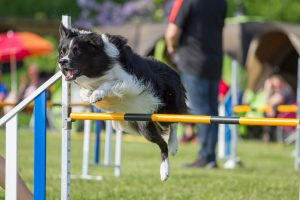
Low Back Injury Prevention
The best cure is prevention. While injury prevention programs don’t reduce injury risk to zero, they do offer the best chance to keep your dog injury free and safe.
Puppies and Young Dogs
Injury prevention starts in puppy-hood. As a budding agility dog owner it’s important that your puppy’s exercise levels are appropriate for their growing bones.
This link provides details of each of the stages of growth and exercises / activities that are safe through these growth periods.
Adult / Competing Dogs
A comprehensive injury prevention program may include:
- Maintenance treatment: Dogs can’t always tell us when they’re feeling tight or sore. A semi-regular check up and treatment ensures good musculoskeletal balance (see complementary therapies above).
- Strength and conditioning program: Attends to any identified strength deficits. These are often completed in the off-season.
- Appropriate rest: The body heals when resting. Any comprehensive training program should include adequate rest.
- Technical correction: Refining skills to maintain safe entry and exit from apparatus. Note that some technique issues are due to lack of strength and conditioning.
Above: An example of technical correction through the completion of a core strengthening program.
Conclusion
Low back injuries are common causes of decreased performance in agility dogs. A comprehensive physical examination will help to determine the cause of the decreased performance. If a disc injury or nerve compression is suspected, an MRI may be required to confirm the diagnosis.
Treatment options range from conservative measures to surgery. Therapeutic exercise will also form an important part of any injury rehabilitation, with core strengthening of utmost importance in low back injuries.
Once you have rehabilitated your dogs injury, or if your dog is currently healthy and performing well, don’t wait until their performance drops. Actively engage in an injury prevention program to give your dog the best chance of remaining injury free.
If you’d like to read more about low back injuries in agility dogs click here.

